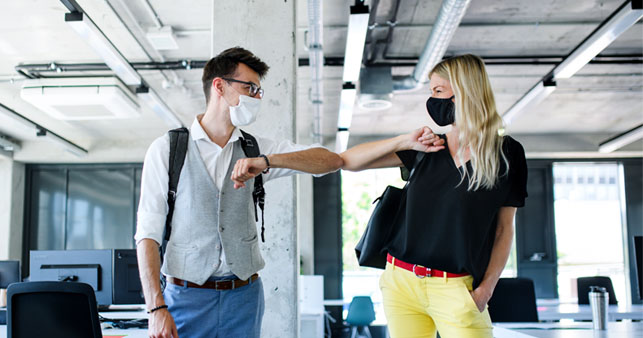
There have been a significant number of COVID-19 cases in the country and while the case rates are trending downward, businesses should still be careful. If they have staff or employees returning to the workplace, they need to implement a safety plan and have policies in place.
Now is not the time to be complacent especially regarding infection control. Everyone still needs to take precautions to protect themselves and others from COVID-19.
When can employees return to work after COVID?
If your employee informs you that they have tested positive or live with a person with COVID-19, they are required to isolate in line with Government regulations.
Ask your employee or staff member to isolate for 7 days. Your employee can not return to work until they have completed 7 days isolation from when either their symptoms started or the date they were tested if they have no symptoms. They can return to work on Day 8.
They do not need to be tested again. If the employee remains significantly unwell, they should not come back to work until they are well.
Contact tracing for businesses is not mandatory. However, staff members or customers may have underlying medical conditions that may be unknown to you and that put them at greater risk of infection. You should inform your staff and customers about the positive case so that they can get tested.
To ensure the safety of other employees, clean and disinfect all areas used by the person who tested positive for COVID-19. You can find further guidelines and information here.
COVID-19 Safety Plan
A business is responsible for the health and safety of its workers and visitors to the workplace. Businesses need to do what is reasonable to keep staff and customers safe from COVID-19. Even though the Government requirements may change depending on the alert level that is currently in place, it is still necessary to conduct a risk assessment of your workplace and put a plan in place to ensure you are minimising the risks of COVID-19 entering the workplace and the spread of infection if it does.
Essentially, you should assess how the disease could enter and be transmitted within your workplace and put measures in place to contain it. Businesses can look at their cleaning practices, the distance between workstations and the supply of sanitiser, and even masks and gloves if employees are handling cash or are in close contact with others.
For more detailed information on risk assessment within your workplace and how to implement a COVID-safe plan check out our blog here.
If Sick Stay Home
If your employees have any symptoms of COVID-19, such as cold or flu symptoms, they are encouraged to stay home and contact Healthline or their doctor to organise a test to ensure they’re COVID-19 negative.
You should make it clear to your customers and visitors to the workplace that if they feel unwell, they should not enter the premises. For example, you could place signage near the entrance of buildings or grounds to ask people with symptoms consistent with COVID-19 not to enter and to call Healthline (0800 358 5453) or contact their doctor.
Businesses don’t need to conduct temperature checks or arrange tests for workers prior to their return to the workplace unless they are working in a high-risk industry, such as the border security, in which case there may be additional protocols to follow.
Working from Home Policy
Having workers work from home is one way that businesses and services can manage the risk of work-related COVID-19 transmission. Allowing your employees the option to work from home can mean happier, motivated, and productive employees.
You can have a working from home policy that answer questions such as:
What is the company policy about working from home?
Do employees need to submit a written request to work from home?
How often can employees work from home?
Will the company provide a work from home setup?
Will the company conduct a risk assessment of the work from home setup?
You should introduce a work from home policy and communicate it to your employees regularly.
Keep Track through the App
As a business you should be keeping track of your customers and helping them record where they have been. Public transport operators, workplaces and businesses must legally display the NZ COVID Tracer QR code poster to help customers keep track of where they’ve been.
Practising Good Hygiene
Consider your workplace cleaning and sanitisation policies and practices. Provide your workers with information on good hygiene. You should also make sure you provide places where the workers can frequently wash their hands and could put up signs outlining handwashing techniques. Most importantly encourage them to keep their workspace and surfaces clean, especially frequently touched surfaces like door handles and stair rails.
Physical Distancing
While not mandatory, physical distancing is encouraged where possible. Try and maintain distance where practical, between staff who are working together all day to reduce the risk of the virus spreading through prolonged contact with other staff members. Avoid sharing equipment between staff members or clean each item thoroughly before and after use with soap and water or disinfectant wipes.
Face Coverings
Encourage your employees to wear a face covering, particularly on public transport on their way to and from work, as an extra measure to stay safe. You may also want to encourage your employees to wear them within the workplace, for example when it is not possible for them to keep their distance from their colleagues. If you would prefer staff to cover up in the workplace, then you need may need to consider changing your workplace policies and procedures and providing face coverings to your employees.

Get Workplace Advice Now
Call Our Team of Expert Advisers Who Will Help You with Your Workplace Questions.
